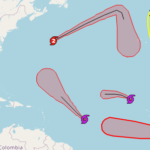The statistical reference period for the hurricane seasons is an important element in the seasonal forecast and in the statistical analysis of a season. It is the annual average over these 30 years that makes it possible to determine whether or not the forecast for the coming year will be more intense than this average.
| 1981-2010 | 1991-2020 | Evolution | |
|---|---|---|---|
| Number of named storms | 12 | 14.4 | 20% |
| Number of stormy days | 59.5 | 69.4 | 17% |
| Number of hurricanes | 6.5 | 7.2 | 11% |
| Number of hurricane days | 24 | 27 | 13% |
| Number of major hurricanes | 2.7 | 3.2 | 19% |
| Number of days of major hurricanes | 6 | 7.4 | 23% |
| Cumulative ACE index | 106 | 123 | 16% |
This table shows the evolution between the previous reference period and the new one. We see that the trend is very clear and overall of the order of 15% to 20% depending on the indicators. The consequence of this development is important since a season so far 15 to 20% more active than the average becomes in fact a season equivalent to the average. It is therefore appropriate to take this development into account in our approach to forecasts because it is very likely that the media will not give this information when they talk about it, which can distort our judgment.
What does this evolution also say
Beyond the simple aspect of comparison with a seasonal forecast or a current season, this evolution is important in our understanding of the climatic evolution in our area. The last 10 years have caused the seasonal average to increase significantly. It is still a little early to draw conclusions on a potential link between climate change and average cyclonic activity, but it can be noted that until now we have tended to anticipate an increase in the power of the systems but not necessarily of an increase in the power of the systems. their number. However, over the last few decades, globally the two indicators have been on the rise.
Of course, in this reading of the figures, it is necessary to take into account the reality of the various regional or global temporal oscillations. 10 years is a very short period on the global climate scale and a notable influence of the oscillation ENSO or North Atlantic can (among others) have specific effects over a period of 10 years. Nevertheless, the comparison on the 10-year slip over a total period of 30 years is already a little more relevant and it indicates to us that we are clearly going in the wrong direction as regards the evolution of the average power of cyclone systems. but also of their number.
However, do not panic!
The evolution of these seasonal figures affects the entire tropical Atlantic basin and the Caribbean and the small territories of the Antilles are marginally impacted by this evolution. As I show in this article the territory of the Lesser Antilles most affected by cyclones since 1950 (the Guadeloupe) was only impacted by around 1% of the basin's activity. A 20% change in global activity will not necessarily have an equivalent impact on our islands over a statistical period of one or two decades. The striking example is last season. It has been the most active season since 1950 on a number of indications and yet the West Indies has been extremely spared.
We must clearly differentiate the overall statistical development of the basin and the daily reality of our small territories. A cyclone that passes over one of our islands will give the feeling of a very active season even if it was not, whereas not being hit by the slightest storm will give us the impression of a calm season even if it is beats almost all records. Like last season!
sources: noaa
To read on the same subject

Forecast hurricane season 2021 in the Atlantic
4.97 / 5 (35) The 2021 hurricane season As usual, the team of Professor Philip Klotzbach from the University of Colorado presented their forecast for the season


